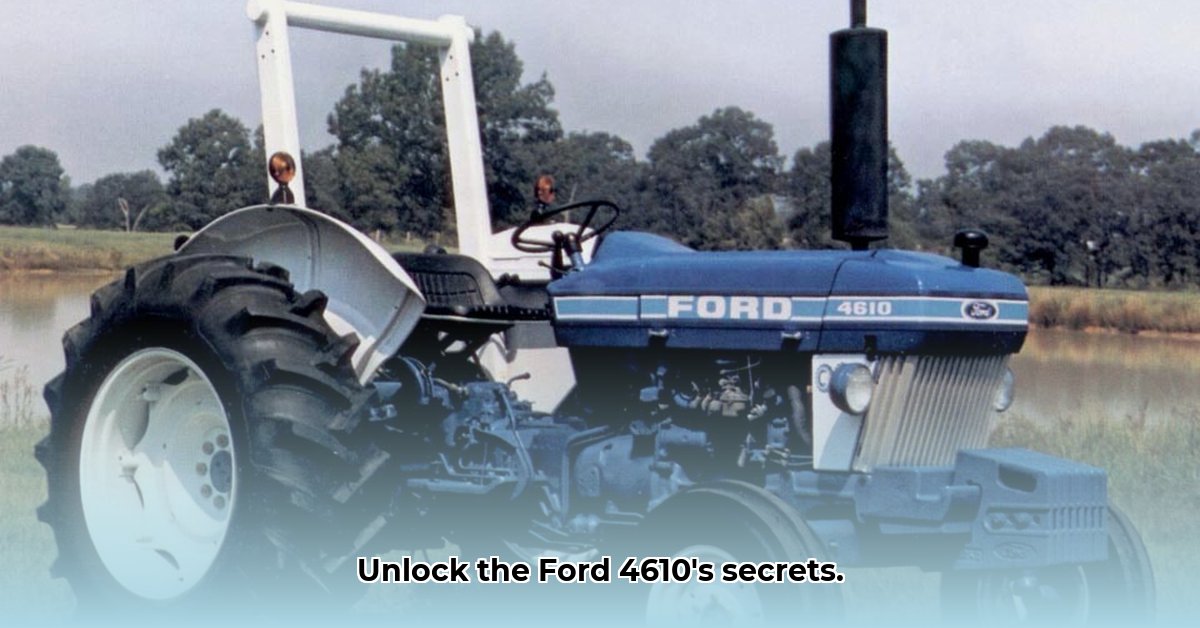
The Ford 4610: a name synonymous with dependability and hard work for generations of farmers. This comprehensive guide delves into the specifications, history, and maintenance of this iconic utility tractor, providing both informational and instructional content for owners, prospective buyers, and enthusiasts alike. Whether you're a seasoned farmer or a curious collector, you'll find valuable insights within. For more on classic Ford tractors, see this helpful resource on Ford tractor specs.
Ford 4610 Tractor Specifications: A Detailed Overview
The Ford 4610, produced between 1981 and 1989, solidified Ford's reputation for building robust agricultural machinery. Its enduring popularity stems from a combination of reliable engineering, adaptable features, and a relatively straightforward design. Let's explore its key specifications:
Engine and Power
The Ford 4610 offered two engine options: a gasoline engine and a more popular three-cylinder diesel engine. The diesel model, displacing 3.3 liters, generally delivered between 47 and 63 horsepower, depending on the year and testing methodology. This power, combined with its robust drivetrain, made it suitable for a wide array of farming tasks. Did you know that the fuel tank capacity of approximately 16 gallons (60 liters) provided a decent working range before refuelling was necessary?
Transmission and Drivetrain
Transmission options varied slightly throughout the production run. Some models featured eight forward and two reverse gears, while others offered eight forward and four reverse gears. This versatility allowed operators to adjust their speed and power delivery to suit the specific task at hand. The robust drivetrain, a hallmark of Ford's engineering at the time, contributed significantly to the tractor's long-lasting dependability.
Hydraulics and Lifting Capacity
The hydraulic system, holding approximately 12.1 gallons (46 liters) of hydraulic fluid, provided ample lifting power for a variety of implements. While simpler than modern closed-center systems, it was sufficient for the tasks typically undertaken by a utility tractor of this size and weight (around 4,806 pounds or 2,180 kilograms). This relatively lighter weight offered advantages in softer ground conditions.
Brakes and Safety Features
Reliable wet disc brakes were standard on the Ford 4610. While safety features were less comprehensive than on modern tractors, some models included a Roll Over Protective Structure (ROPS) and even a cab, enhancing operator protection. Prioritizing safety is crucial when operating any agricultural equipment.
Maintaining Your Ford 4610: A Practical Guide
Maintaining a classic tractor like the Ford 4610 requires dedication, but the rewards are significant. Proactive maintenance extends the life of your machine and safeguards against costly repairs down the line.
Regular Fluid Changes: Regular oil changes (using the correct grade of oil specified in your owner's manual), filter replacements (fuel, oil, air), and diligent coolant level checks are crucial for optimal engine performance and longevity. This simple step can prevent major issues.
Parts Sourcing: While many parts are currently available, their future availability is uncertain. Proactively establish relationships with reliable suppliers to avoid potential delays and higher costs in the long run.
Consult the Service Manual: The factory service manual is your most valuable resource. It contains detailed diagrams, specifications, and troubleshooting guides.
Seek Expert Advice: If you lack mechanical experience, connect with a mechanic familiar with older Ford tractors for assistance with repairs and maintenance. This can save you time, money and frustration.
Ford 4610 Parts Sourcing: Tips and Strategies
Locating replacement parts for your Ford 4610 requires a strategic approach. Several avenues for sourcing parts exist:
Original Equipment Manufacturers (OEMs): While Ford no longer produces this model, some parts may still be available directly from Ford or authorized dealers, although expect higher costs.
Aftermarket Suppliers: Many aftermarket suppliers specialize in providing parts for older tractors, often at lower costs compared to OEM parts. Choosing reputable suppliers is vital to avoid inferior quality or counterfeit parts.
Online Retailers: Websites dedicated to vintage or classic tractor parts offer a broad selection and convenience, but always read reviews carefully before purchasing.
Local Tractor Supply Stores: Your local store may carry some common components or be able to order them for you. This is a good choice for quickly obtaining readily available items.
Used Parts Dealers: These dealers can offer parts at significant discounts, but a thorough inspection is paramount before purchase to ensure their quality and functionality.
Online Forums and Communities: These online communities provide invaluable insight and recommendations from experienced Ford 4610 owners.
Key Considerations:
- Accurate Part Identification: Use your owner's manual to get the correct part numbers.
- Cross-Referencing: Explore cross-referencing to find compatible parts from other manufacturers.
- Visual Verification: When purchasing online, having images of the part is extremely beneficial for accurate matching.
- Reputation Check: Carefully evaluate reviews of parts suppliers and their reliability.
- Warranty: Always seek a warranty to protect your investment.
Troubleshooting Common Issues: A Proactive Approach
Before ordering replacement parts, consider basic troubleshooting steps that might resolve your problem.
Inspect Connections: Loose wires or connections are a frequent cause of malfunctions. Begin by thoroughly checking all electrical connections.
Check Fluid Levels: Low oil, hydraulic fluid, coolant, or fuel levels can cause serious issues. Ensure all fluids are at the correct levels as specified in your manual.
Clean Filters: Clogged air, fuel, or hydraulic filters restricts airflow or fluid flow, impacting performance. Cleaning or replacing these filters may solve the problem without the need for costly part replacement.
This guide provides a comprehensive overview of the Ford 4610's specifications and essential maintenance practices. Remember, proactive maintenance and careful parts sourcing are key to keeping your 4610 running smoothly for years to come.